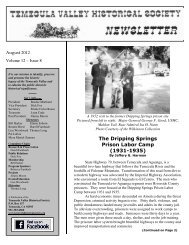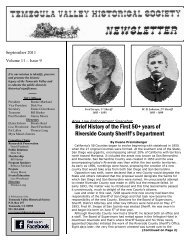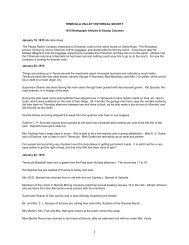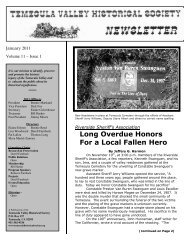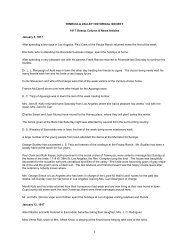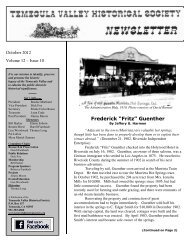Lake Henshaw Dam - Temecula Valley Historical Society
Lake Henshaw Dam - Temecula Valley Historical Society
Lake Henshaw Dam - Temecula Valley Historical Society
You also want an ePaper? Increase the reach of your titles
YUMPU automatically turns print PDFs into web optimized ePapers that Google loves.
June 2011<br />
Volume 11 – Issue 6<br />
It is our mission to identify, preserve<br />
and promote the historic<br />
legacy of the <strong>Temecula</strong> <strong>Valley</strong> and<br />
to educate the public about its<br />
historical significance.<br />
_____<br />
2011 Officers<br />
President Bonnie Martland<br />
Vice President Dick Fox<br />
Secretary Elaine Culverhouse<br />
Treasurer Bill Harker<br />
Past President Jimmy Moore<br />
Directors<br />
Elaine Eshom Bonnie Reed<br />
Lisa Woodward Darell Farnbach<br />
Pat Lallou Thomas Long<br />
Myra Masiel-Zamora<br />
Committee Chairs<br />
Research & Preservation<br />
Darell Farnbach<br />
Public Relations<br />
Dick Fox<br />
Membership<br />
Bill Harker<br />
Program Speakers<br />
Rebecca Farnbach<br />
Projects<br />
Jimmy Moore<br />
Events/Education<br />
Lisa Woodward<br />
Historian<br />
Thomas Long<br />
A Publication of the<br />
<strong>Temecula</strong> <strong>Valley</strong> <strong>Historical</strong> <strong>Society</strong><br />
P.O. Box 157<br />
<strong>Temecula</strong>, CA 92593<br />
951-303-6860<br />
www.temeculahistoricalsociety.org<br />
This 1932 photo of the <strong>Lake</strong> <strong>Henshaw</strong> <strong>Dam</strong> shows the completed dam.<br />
An Early Area Water Project<br />
<strong>Temecula</strong> Active During<br />
Building of Warner’s (a.k.a.)<br />
<strong>Lake</strong> <strong>Henshaw</strong> <strong>Dam</strong><br />
By Jeffery G. Harmon<br />
“The Bent Construction Company of Los Angeles was the<br />
successful bidder for the construction of the Warner dam and will start<br />
the work within the next sixty days. All the material will come through<br />
<strong>Temecula</strong>.” (Mrs. V.B. Sands, <strong>Temecula</strong> Gossip Column, <strong>Lake</strong> Elsinore<br />
<strong>Valley</strong> Press, May 19, 1922).<br />
In 1911, William G. <strong>Henshaw</strong> purchased the Warner Ranch from<br />
the heirs of John G. Downey. <strong>Henshaw</strong> and his partner, Col. Ed Fletcher,<br />
set plans in motion to construct a dam at the headwaters of the San Luis<br />
Rey River. The dam would create California’s second largest artificial lake<br />
to date. A tunnel and the head gates were constructed within a few<br />
years, but then the dam project halted at the start of World War I.<br />
After the war, Fletcher began advocating for the right to complete<br />
the <strong>Henshaw</strong> <strong>Dam</strong>. On April 11, 1922, it was announced that the<br />
contract for the dam had been awarded to the Bent Brothers of Los<br />
Angeles.<br />
H. Stanley Bent explained the project: “The big dam is to be of<br />
dirt construction, which means that it is simply a great dirt fill in the San<br />
Luis Rey River. Approximately half a million cubic yards of earth will be<br />
used in making the fill, which will extend for 600 feet up and down the<br />
(Continued on Page 2)
Calendar<br />
Of Events<br />
Saturday, June 11 –<br />
Flea Market in the Park to<br />
Benefit the <strong>Temecula</strong> <strong>Valley</strong><br />
Museum. 8:30 to 3:00 p.m.<br />
Approximately 100 vendor<br />
booths will be available with<br />
a variety of items. Be sure<br />
to stop by the TVHS booth.<br />
Saturday, June 25 –<br />
Historic Route 395 Fun Run<br />
Rally. Drive a segment of the<br />
Historic Route 395 starting<br />
either in Perris or Escondido,<br />
Finish with free eats & music<br />
At Elder House in Fallbrook.<br />
Contact either Dick Fox,<br />
Jimmy Moore, or Jeffery<br />
Harmon for details.<br />
Monday, June 27 –<br />
Monthly meeting at Little<br />
<strong>Temecula</strong> History Center,<br />
6 to 8 p.m. Presentation by<br />
Steve Allen and Alan<br />
Brubaker on the History of<br />
Photography.<br />
Monday, July 25 – Monthly<br />
Meeting at Little <strong>Temecula</strong><br />
History Center, 6 to 8 p.m.<br />
Darell Farnbach will do a<br />
presentation on “Ranching<br />
California Style”.<br />
___<br />
Membership Activity<br />
New Member<br />
Margot Maitland<br />
Renewals<br />
David Elliott & Anne Miller<br />
Gera Thole<br />
Keith Johnson<br />
Neal & Dawn McKenzie<br />
Vince & Audrey Cilurzo<br />
Walt & Jean Dixon<br />
Darell & Rebecca Farnbach<br />
Bonnie Martland<br />
Dick & Evelyn Norris<br />
Robert & June Ulrey<br />
TVHS Newsletter, Volume 11 – Issue 6<br />
Published by <strong>Temecula</strong> <strong>Historical</strong> <strong>Society</strong><br />
Page 2 – June 2011<br />
Building of <strong>Henshaw</strong> <strong>Dam</strong> (Continued from Page 1)<br />
stream at the base and be about twenty feet at the top. It will be 105<br />
feet above stream bed. It will be faced on the upper side with a concrete<br />
slab or shell to prevent damage by the wave action of the reservoir and<br />
the spillway will be of concrete. At the foot of the spillway the structure<br />
will be protected by masses of rock to prevent any damage from the<br />
falling water. There will also be concrete abutments of piers to prevent<br />
possible encroachments of the water at the banks.” (Daily Times<br />
Advocate, June 5, 1922)<br />
By June, the San Diego Consolidated Gas & Electric Company<br />
began constructing high power transmission lines from Rincon to the job<br />
site. The Bent Brothers constructed a large worker’s camp complete with<br />
offices, housing, cooking and dining room. More than 300 men were<br />
hired to construct the dam, and more would be added as the project<br />
progressed.<br />
The first supplies to roll into the <strong>Temecula</strong> Depot were mules.<br />
Some were brought in from as far north as San Luis Obispo. They were<br />
used at the construction site to haul wagons of dirt to the dam fill site.<br />
Two steam shovels dug into the bank and dumped two scoops on the<br />
waiting wagon. The mules then hauled the load like modern dump<br />
trucks.<br />
The next supplies to arrive at the <strong>Temecula</strong> Depot were cars of<br />
cement. “The first car of cement for the Warner dam was received<br />
Tuesday. Henry Gray has the contract to haul it from here to the dam.”<br />
(LEVP, June 30, 1922)<br />
The cement came from the Riverside Portland Cement Company,<br />
whose president was William G. <strong>Henshaw</strong>. Escondido businessmen had<br />
hoped that all supplies would come through their depot, but it was more<br />
economical to send the supplies through <strong>Temecula</strong>. It is believed that<br />
Henry Gray’s trucks would have transported the cement from the depot,<br />
through Pala and then along the San Luis Rey River bank to the dam site.<br />
The Bent Bros had hoped to finish the dam by December 1 st in<br />
order to collect the coming winter rains. Flood lights at the dam allowed<br />
work to continue twenty-four hours a day with three shifts. As deliveries<br />
increased at the <strong>Temecula</strong> Depot, Henry Gray began running six large<br />
trucks to the dam site daily.<br />
On Christmas morning the dam was completed and the gates<br />
were closed. The waters began to slowly rise, and soon <strong>Lake</strong> <strong>Henshaw</strong><br />
was formed. “. . . (With) the closing of the gates of the reservoir, there<br />
went down into the history of that section of Southern California the<br />
completion of what is considered the greatest work of development in the<br />
northern part of San Diego County in more than thirty years.” (Los<br />
Angeles Times, December 26, 1922).<br />
In January, the mules returned to the <strong>Temecula</strong> Depot to be<br />
shipped to the next job site. “The Pioneer Truck Co. of San Diego, who<br />
had the contract of excavating the dirt at the Warner dam, has shipped<br />
this week 120 mules and 30 wagons to several other camps.” (LEVP,<br />
January 19, 1923)<br />
The dam began providing irrigation water for 50,000 acres of land<br />
in San Diego’s North County region. “The development of towns in that<br />
section of the county will be one of the greatest outcomes of the<br />
enterprise” (LAT, December 26, 1922). Diverted water from the <strong>Henshaw</strong><br />
<strong>Dam</strong> helped the cities of Escondido, San Marcos, Vista and Oceanside<br />
develop a large citrus industry.<br />
In 1971, state inspectors determined that the <strong>Henshaw</strong> <strong>Dam</strong><br />
would fail in the event of seismic activity. Reports showed that the dam<br />
had been constructed within the Elsinore fault zone. Between 1978 and<br />
1979, the waters were released and the lake shrank. Today the dam<br />
operates at less than 40% capacity. However, <strong>Lake</strong> <strong>Henshaw</strong> is still a<br />
beautiful weekend destination. Drivers can still follow Henry Gray’s truck<br />
route to view the wonderful dam that <strong>Temecula</strong> helped build in 1922.
President’s<br />
Message<br />
My interest was piqued when we<br />
received a request from Robin Smith,<br />
a graduate student at the graduate<br />
school of education at the University<br />
of California, Riverside. She is taking<br />
a class on the history of education in<br />
the inland Empire and has discovered<br />
that not much research has been<br />
done on the history of schools and<br />
districts in the Inland Empire. Their<br />
class goal is to start compiling a local<br />
history on the role of education in the<br />
IE. Robin is interested in the local<br />
history of <strong>Temecula</strong> Schools and the<br />
district, and she most particularly has<br />
an interest in the role of female<br />
teachers around the early 1900’s.<br />
Darell Farnbach and I had a<br />
gentleman stop and talk to us awhile<br />
back at the TVHS information table at<br />
a Rod Run. He talked to us about his<br />
grandmother who attended school in<br />
Sage, but took her high school<br />
graduation exam, administered by a<br />
county qualified examiner, at the<br />
Welty Hotel. This occasioned her<br />
meeting the young man who would<br />
become our gentleman’s grandfather.<br />
The hotel served as a temporary<br />
school starting in 1889. Phil Brigandi,<br />
in his book, “<strong>Temecula</strong> at the<br />
Crossroads of History” mentions a<br />
letter sent by Frank Burnham to<br />
Horace Parker, just after the turn of<br />
the century, in which he talks about<br />
how his teacher quickly put a stop to<br />
the boys’ lunchtime skinny dipping<br />
escapades in Murrieta Creek. Though<br />
not specifically about the teacher,<br />
even such personal glimpses as these<br />
help us envision what school was like<br />
in early <strong>Temecula</strong>.<br />
As a retired <strong>Temecula</strong> teacher and<br />
local history advocate, I have often<br />
thought that a good, comprehensive,<br />
history of education in the <strong>Temecula</strong><br />
<strong>Valley</strong> was overdue.<br />
If you have any information,<br />
particularly primary sources<br />
(correspondence, photos, newspaper<br />
articles, notes, diaries, etc.) or<br />
secondary sources that could be<br />
helpful to Robin and are willing to<br />
share with her, or to let her view,<br />
please contact her at 619-647-4636<br />
or email her at rsmit011@ucr.edu. It<br />
would be nice to share copies of your<br />
material with TVHS also.<br />
Bonnie Martland<br />
TVHS Newsletter, Volume 11 – Issue 6<br />
Published by <strong>Temecula</strong> <strong>Historical</strong> <strong>Society</strong><br />
Page 3 – June 2011<br />
Are There Monsters Among Us<br />
By Duane Preimsberger<br />
I’ve never paid a whole lot of attention to tales of Sasquatch;<br />
large, wild, hairy, bipedal beasts that roam the forests of the Pacific<br />
Northwest and elsewhere. Stories about the Yeti in Tibet, Yowies in<br />
Australia and Bigfoot in the forests of California have usually left me<br />
skeptical. Some of the supposed sightings and photographic evidence<br />
have been shown as fabricated! Growing up and living my adult life in<br />
Southern California has saved me from the fear of venturing into our local<br />
mountains where I might run into a giant, fur covered, bad smelling manlike<br />
creature, until recently.<br />
A few days ago, my wife Judy and I were at the <strong>Temecula</strong> History<br />
Center when I was provided with an article entitled “Death Alley,” by Jeff<br />
Smith. According to Mr. Smith, when the first Europeans came into the<br />
San Diego area, local Indians spoke of hairy human giants living in<br />
arroyos to the east who were warlike and violent. His tale also speaks to<br />
a series of terrible deaths along the Butterfield Stage route between 1858<br />
and 1888. Several were attributed to a wild man, who brutally strangled<br />
his victims, leaving the violence ravaged bodies near an aptly named<br />
location, Deadman’s Hole, a stage coach watering spring about eight<br />
miles northwest of Warner’s Ranch, not that far from <strong>Temecula</strong>.<br />
As the years went by, at least seven dead bodies were found near<br />
Deadman’s Hole, four of them, three men and a woman were found<br />
viciously strangled, their necks broken and surprisingly, their valuables<br />
untouched. Others, who traveled along the route simply disappeared.<br />
West of Deadman’s Hole is another frightening location, Dark<br />
Canyon, a place with walls so steep and narrow that sunlight comes only<br />
at mid-day. Two Julian residents, Charles Cox and Edward Dean made<br />
plans to search the canyon and brave the tangles of thick brush<br />
sometimes taller than a man that added to the gloom. At one point, while<br />
trying to get a clearer look at their surroundings, they scaled a portion of<br />
the canyon wall and spotted a large animal resembling a bear. It walked<br />
upright like a man. Fearful of this strange beast, Cox aimed his rifle and<br />
fired, the beast screamed in a humanlike manner and fell to the ground,<br />
dead.<br />
Cox and Dean approached the hairy body and estimated that it<br />
weighed approximately four-hundred pounds. The creature was about six<br />
feet tall with a dark wrinkled face that appeared to be Indian, and teeth<br />
that were plainly those of a carnivore. It had strange feet, approximately<br />
twenty-four inches long, and eight inches wide with a hard pad like sole.<br />
Nearby, the two men found a cave like dwelling, ten feet deep that<br />
appeared to have been hand carved out of the slope. Inside were five<br />
human skulls, other bones, a partially eaten goat and a resting place<br />
made from local grasses and plants.<br />
Unfortunately, although Cox and Dean made plans to bring the<br />
body of the dead beast to the authorities in a borrowed wagon, they<br />
didn’t follow through.<br />
Another mysterious tale about scary, hairy, two legged beasts<br />
comes from Bigfoot Expert, Ken Coon. Ken interviewed a fellow who was<br />
camping alone at Borrego Sink back in 1939 when he had a frightening<br />
encounter. In the light of his blazing campfire he was suddenly<br />
approached by a pack of white and silver furred bipedal creatures with<br />
red eyes. They hung around for awhile but were frightened off by the<br />
heat and flame from the campfire. Three decades later, Harold Lancaster<br />
who was camping in the same general area of the Sink when he saw a<br />
large ape-like beast approaching him.<br />
Lancaster feared the worst so he drew his revolver and fired<br />
warning shots into the air. The noise caused the beast to startle, jump a<br />
good three feet straight up and run away! Although these supposed<br />
incidents were interesting to me they also seemed to lack any real<br />
supporting documentation and although (Continued on Page 4)
Monsters Among Us<br />
(Continued from Page 3)<br />
I don’t discount them, I’d like<br />
more proof.<br />
I did locate an organization that<br />
tracks sightings. The Bigfoot Field<br />
Researchers Organization (BFRO)<br />
has records of over 400 sightings<br />
in California since 1998. Twentyfive<br />
of them have been in<br />
Riverside, San Bernardino and<br />
San Diego Counties. Since none<br />
of them have been in the area<br />
close to Ynez and Pauba Roads in<br />
the City of <strong>Temecula</strong>, I still feel<br />
pretty safe in strolling through my<br />
neighborhood, even after dark.<br />
Oh, by the way. BFRO has<br />
suggested that a very bright light<br />
shined into the eyes of Bigfoot<br />
will generally cause them to flee.<br />
Did I mention I have a Maglight in<br />
my pocket during evening walks<br />
###<br />
Gene Knott’s<br />
<strong>Temecula</strong> Memories<br />
(From interview with Jeffery Harmon,<br />
March 26, 2002)<br />
“To call Rainbow, the call would<br />
go north through Corona, around<br />
to the coast to San Diego, and<br />
then to Rainbow. You could<br />
almost drive to Rainbow faster<br />
than placing a phone call. I’m<br />
sure you’ve heard stories about<br />
our ‘switch board operator’ Edna<br />
Swanguen. She and her<br />
husband, Carl, were pioneers<br />
here and operated a small café<br />
that doubled as the Greyhound<br />
Bus Stop. She used to take her<br />
own sweet time answering your<br />
call, especially when she was<br />
busy waiting on customers. They<br />
had the switchboard in their<br />
bedroom so they could provide<br />
service around the clock<br />
(provided they weren’t sleeping,<br />
of course). The people who<br />
complain about service today<br />
should have experienced our<br />
power and telephone service of<br />
those days! Carl and Edna<br />
Swanguen were just two more<br />
individuals that made <strong>Temecula</strong><br />
unique.”<br />
TVHS Newsletter, Volume 11 – Issue 6<br />
Published by <strong>Temecula</strong> <strong>Historical</strong> <strong>Society</strong><br />
Page 4 – June 2011<br />
From the Archives<br />
Alfred Standford Burnham Passes<br />
(From the Elsinore Leader Press, May 20, 1943)<br />
Prominent Pioneer of Elsinore<br />
Passed Away on Sunday Morning Last<br />
The news of the death of Mr. Alfred Standford Burnham,<br />
better known to hundreds of our citizens as Al Burnham, came<br />
as a distinct shock to the community on Monday morning last,<br />
as he had been ill but a short time having had an attack of low<br />
blood pressure and a recent illness of the flu. While these<br />
attacks were quite severe he had so far recovered that he was<br />
able to come down town during the past weekend but suffered a<br />
severe relapse on Sunday last and was taken to the Community<br />
hospital where he was placed under an oxygen tent, but to no<br />
avail, and passed peacefully away at 5:50 a.m. Monday<br />
morning.<br />
Alfred Standford Burnham was born in Iowa and came to<br />
California in 1886 at the age of four and with his parents first<br />
resided on the Burnham farm, better known now as the Morrell<br />
place, near Rome hill on Grand Avenue. He attended school<br />
during his boyhood days at Wildomar, after which he farmed<br />
here in the valley for seventeen years. He then took a position<br />
with his brother, George in his store at <strong>Temecula</strong> where he<br />
remained for seven years.<br />
He then moved to the state of Washington where he was<br />
associated with another brother in the general merchandise<br />
business for a year. Selling out and returning to Elsinore he<br />
entered into the grocery business where he remained at his<br />
Main Street business for seventeen years. In 1926 he sold his<br />
business and entered business in Alberhill where he remained<br />
until 1941 when he retired. Since that time he has been at his<br />
home on West Graham Avenue.<br />
He had been quite active in civic affairs and for years was<br />
a member of the city council, mayor of the city and a member of<br />
the board of education of the high school.<br />
He leaves to mourn his loss, his wife, Mrs. Laura<br />
Burnham; his brother, Charles Burnham; another brother,<br />
Postmaster Louis Burnham; two sisters Mrs. Harry Harris and<br />
Mrs. Mildred Curtis, and one daughter, Mrs. Anna Schmalried ,<br />
of South Gate; two sons, Alfred Standford Burnham who lives in<br />
Long Beach and is Deputy Internal Revenue Collector, also<br />
Lawrence Burnham, who recently entered the Army. He also<br />
leaves a sister-in-law, Mrs. George Burnham of <strong>Temecula</strong>.<br />
In passing he leaves a void in the hearts of the hundreds<br />
of friends, who had learned to love him and respect his high<br />
ideals, his frankness and his earnestness and to enjoy his<br />
friendship. He was an active member of the local Masonic body.<br />
Funeral services were held in the funeral parlors of the<br />
Everett and Peterson mortuary on Wednesday at 2 o’clock. Rev.<br />
J. L. Cameron, retired pastor of the Presbyterian Church,<br />
officiated.<br />
Pallbearers were two brothers, Charles and Louis<br />
Burnham, two brother-in-law, Harry Harris and Millard Curtis,<br />
and Frank and Paul Ware, nephews of the deceased.<br />
Burial was in the Elsinore <strong>Valley</strong> Cemetery.



